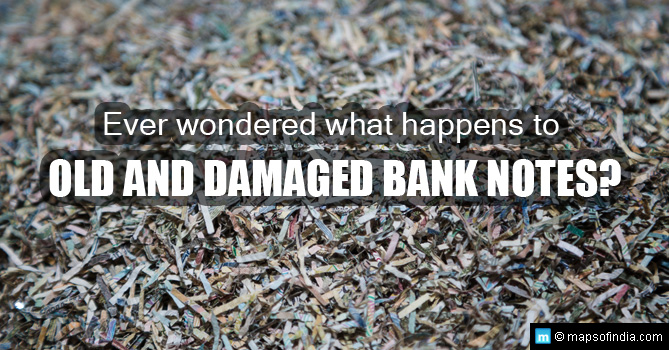The old Rs 500 and Rs 1000 currency notes are gone but have you ever wondered what happens to those once they are out of the system? Don’t be surprised to learn that the piece of furniture you have been eyeing may well be made up of the same Rs 500 and Rs 1000 notes. While you are not going to go laughing all the way to the bank, you can be proud to have a bit of history in your house, if you are lucky.
Much of the old currency notes will be now used to make plywood, and soft and hard boards. Plywood, hard board and soft board go into making all kinds of furniture and partitions.
Have a look: Bird Talk: Queues of Pain
So how do these soiled, torn or demonetized notes end up in plywood panels?
While currency demonetization as a move has been largely welcomed by the people, it has posed a major problem for the Reserve Bank of India (RBI). The recently withdrawn 23 billion pieces of former Indian currency need to be disposed off and how. Apparently, when stacked vertically, it would be higher than the Mount Everest. Enough to give you an idea of the mountain of a problem before the RBI.
Shortly after the Prime Minister Narendra Modi made his surprise announcement, Western India Plywoods Limited (WIPL) based in Valpattanam in Kerala approached the RBI for buying the shredded notes through tender and the RBI gladly complied.
Normally, plywood and similar board manufacturing uses wood pulp as a major ingredient to make hard board, press board and soft boards. WIPL found that when 7% of shredded currency was mixed with wood pulp and pressed together, it made excellent boards, without compromising the strength, density or quality of the boards. And, it was cost effective as well. RBI sold the shredded currency at the rate of Rs 250 per ton to WIPL and absorbed the cost of transportation. That made good commercial sense for WIPL as well.
Why did RBI choose WIPL?
It is interesting that RBI actually offered 15 bags of shredded currency notes on a trial basis to WIPL a few days prior to the November 8 announcement by PM Modi, with a promise of supplying larger quantities if it was satisfied by the results. WIPL had no idea of what was coming.
WIPL has the advantage of operating a 2500-KW Swedish pulping machine that is heavy-duty and can crush and press all kinds of wood pulp and also process these shredded currency notes, unlike other processors in the newsprint and Kraft paper industry.
Since demonetization, WIPL has received 40 tonnes of shredded currency notes per week, as it cannot process more than that. Although RBI is in a position to supply far higher quantities under the present situation.
The use of shredded currency in plywood panel making is a better option than using it as landfill, since the currency uses a lot of inks and chemicals that could negatively impact the soil in the long term.
The story of RBI’s currency shredding
The RBI is responsible for printing currency notes and is also responsible for receiving back old, soiled or torn notes and replace these with new currency notes.
The practice until 2001 saw the RBI collect these old notes and manually sort them into those which could still be circulated and those that could not. The rejected notes were then burnt. The problem with this process was that it was manual and therefore, time-consuming, costly and inefficient. And burning of large amounts of currency notes was plain bad for the environment.
So in 2003, the then RBI Governor Bimal Jalan introduced the Currency Verification and Processing System (CVPS) and the Banknote Shredding and Briquetting System (BSBS). The CVPS is an imported technology that uses an automated system to identify, grade and sort currency notes on a large scale. The CVPS can process 60,000 pieces of currency notes per hour or 4.8 lakh pieces in an 8-hour shift. RBI has 27 shredding machines spread over 19 locations.
The system can identify fake currency notes and separate those from the genuine ones. Of the genuine ones, it can further sort these between the ones that can be used and those that need to be taken out of circulation. The CVPS then sends the rejected notes to the BSBS system, which finely shreds each currency note and then presses them into briquettes that are mostly cylindrical in shape. Larger briquettes weigh around 600 kg per cubic meter.
In FY ’12-‘13, RBI shredded around 14 billion pieces of rejected currency notes. In FY ‘15-‘16, the number rose to 16 billion currency notes and it is estimated that in FY’16-‘17, RBI will shred over 20 billion pieces. That’s a lot of shredded currency volume to dispose.
While some currency scrap dealers buy the briquettes from RBI and then process it further by adding chemicals to make them usable in industrial furnaces and also for cooking fires. Some are recycled into office files, calendars and even paper-weights as souvenirs. Since chemicals used in the currency notes can be harmful to the environment when burned or to the soil when used as landfill, the RBI prefers to offer these for commercial processing as in the case of WIPL.
How do other countries deal with the problem?
The Bank of England in 1990 used rejected currency notes to burn and heat residential and commercial spaces. But that was discontinued since burning was a pollutant. They have since experimented with composting, with apparently positive results on soil.
The US Federal Reserve uses shredded currency as landfill and a small quantity is cut and used as souvenirs. Between 2009-10, the Fed Reserve had processed around 12 billion pieces of rejected currency.
There’s an opportunity in every waste
The RBI has taken the right path of processing rejected currency in a manner that adds commercial value and yet does not negatively impact the environment. Nice to see the government see waste as an opportunity for the industry.
Read More…
Tourist Season Faces Brunt Of Demonetisation
7 Spiritual Lessons from the Currency Invalidation in India
Next on PM Modi’s Radar: Rich Misusing the Jan Dhan Accounts
Paytm, Mobikwik, Freecharge: eWallet Reviews and Comparison
How to Convert Black Money into White
Modi launches the biggest fight against Fake and Black Money





